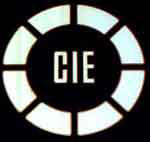 CIE
logo
CIE
logo
 CIE
logo
CIE
logo
Came into being in 1945, when the GSR was amalgamated with the Dublin United Transport Company. All road and rail services, except in the areas under the jurisdiction of the GNRI came under the monopoly of CIE. Over 2600 miles of track were involved. The company was nationalized in 1950. On 1/10/1958 the GNRB operations in the the 26 counties were vested in CIE. In 1987 three new subsidiary companies were established to operate under the overall control of CIE. They included Iarnród Éireann, or Irish Rail and Dublin and provincial bus companies. Besides the railways, Irish Rail included the DART (Dublin Area Rapid Transit - the Howth to Bray line) system, the catering service, Rosslare Harbour and the Inchicore Works.
Rolling stock: Inherited GSR locos. Experiments
with turf burning engines from 1952-1957 were unsuccessful.
First diesels were 5 shunters with Mirrlees engines built
at Inchicore Works in 1947-8. Two mixed traffic Bo-Bo locos
were built in 1950-1 with Sulzer engines. Dieselization
began in earnest in 1955 when an order placed with
Metrovick for 94 diesel electrics (60 1200hp and 34 550hp)
with Crossley engines. Also 48 [BC: 60 1952-4] diesel
railcars were obtained from AEC and a further 6 were built
at Inchicore. The Metrovicks were delivered between
1955-57. 12 other 960hp engines with Metrovick
transmission, Sulzer engines and Birmingham R.C.W. bodies
were also purchased plus 3 small 130hp diesel hydraulics
Deutz locos (7 further added in 1962). 19 400hp diesel
hydraulic engines with Maybach engines were built at
Inchicore from 1955 and a further 14 in 1961. The first of
a fleet of 15 GM Bo-Bo 950hp locos was introduced in 1961
to eliminate steam which still dominated the ex GNRB
section. A further 37 were bought in 1962 (resulting in the
ending of steam in April 1963) and 12 in 1966. From 1967
the earlier Crossleys were reengined with GM units. 18
2400hp Co-Co locos were later purchased from GM. Coaches
from BREL in 1973.
Works: Inchicore. Broadstone for repairs in early
years, wagon repairs up to 1961.
Livery: CIE - Locos: For a number of years all
but the 800 class (green) were painted dark grey [and cast
plates on tank sides were replaced by painted yellow
numerals EFC], but subsequently the larger passenger
engines, Dublin suburban tanks and diesels were painted
green at the end of the forties. Diesels were silver.
Coaches were malachite green with apple green line at
waist, flying snail and numbers. Later livery was brown to
waist, black above to top of windows and white line to
roof, with new CIE emblem. [Baker] From 1946 GSR
numberplates were replaced by large yellow unshaded painted
numbers (except 800 class). From early 1947 all 4-6-0s,
Woolwich 2-6-0s, three 4-4-0s and DSE suburban section tank
engines were painted green, lined black and yellow. In its
last years most surviving steam was black. [EFC: In July
1948 engines were light green lined out black and white,
buffer beams and motion plates vermillion - No.502 being
the first engine in the new livery. 1951 bluish green lined
out in black and white]. First diesels were silver, some
around 1960 light green. Single cab GN B class originally
grey. Experimental orange (officially gold) broad lower
band, black middle, white upper band and black roof tried
out in summer 1961 and later adopted as standard. Many
variations of this have been applied. Carriages were
originally dark green with flying snail emblem, pale green
broad stripe above and below windows. Lighter shade with
pale green waist came in with Park Royals in 1955; also
applied to railcars. At end 1955 unpainted aluminium
coaches were introduced with large red 1s and 2s to
indicate class and small red running nos.. From 1958 all
carriages repainted standard green. New livery in 1961 -
deep orange lower panels, white waist stripe, black upper
panels, roofs and ends. Wagons were reddish brown,
departmental stock grey. In 1973 locos were all over gold
brown with a black band at window level, the band just a
little broader than the full depth pf that on the BREL MkII
coaches. Irish Rail new livery in 1988 used the hitherto
standard golden brown and black with the addition of a
narrow band of white (about 10 cms) on each side of the
black portion. The CIE logo (wheel of eight segments) was
replaced by the IE logo on the black part of the loco. On
coaches the words InterCity are shown in large white on the
lower brown section. Craven coaches and ex-BR MkI generator
vans continued in CIE black, white and golden brown. New
Rivers locos in 1995 received orange livery with black and
yellow stripes. DMUs leased from NIR remained in grey
(windows) maroon (waist) livery but with IE logo replacing
that of NIR on the front diamond. For IE stations from
1996, dark green and light cream replaced dark blue.
Staff: CMEs included O.V.S.Bulleid 1949-1958. The
first CME of Irish Rail was R.Grainger. General Managers
included Sean Lemass to 1970, D.Herlihy 1970-2,
J.J.Byrne
Signalling: Absolute block working and
Harper's instruments on CIE double lines and former GNR
main line. On Rosslare line automatic signals progressively
introduced. Single lines on token system. On former GSR and
GNR token was train staff with Electric Train Staff working
on most. On some sections large 2ft. staffs were still seen
in 1967, but preference was for miniature staffs. First CTC
system in 1976 from Inchicore to Ballybrophy and branches
as far as Athy and Tullamore. CTC at Amiens St. from 1983
and Greystones-Bray by track circuit block.In 1984
converted to computer based and extended from Tullamore to
Ballinasloe, Knockcroghery and Moate. Similar system in
early 1980s for line between Malahide and Greystones plus
Howth branch.
Tickets: CIE central ticket printing headquarters
at Broadstone. Almex machines using continuous paper roll
introduced in 1964.
Further reading: B.Pender & H.Richards, Irish Railways Today, O.Doyle & S.Hirsch, Railways in Ireland 1834-1984, Michael C. Baker, Irish Railways since 1916, B.Carse, "The Transplant Story" JIRRS 1072, Jack Patience, CIE 1958 to 1962: Irish Railway Photographers, Anthony Burgess, Chasing the Flying Snail Irish Railway Photographers, Ernie Shepherd, Bulleid and the Turf Burner and other experiments with Irish steam traction .
Web: For a good treatment, see Steve Johnson on CIE History.


Two earlier CIE logos
The so-called flying snail (which, incidentally, had left
and right side versions) was current from the beginning of
the CIE epoch (dating from four years earlier in 1941 when
the Dublin United Transport Company Ltd. adopted the device
with the wording Iomchar Atha Cliath - Dublin Transport -
on the middle bar) to 1964, after which it was replaced by
the wheeled logo. In 1987 new logos were adopted. One logo
showed a double junction from a four line track (Copy
kindly supplied by L. Boyce). The IE logo was introduced in
1994.


IE logos
Locomotive nameplates:
 IE
nameplate. Source: D.Cronin
IE
nameplate. Source: D.Cronin
Fitzpatricks (New York)
Works & tenderplates:
Carriage plates:
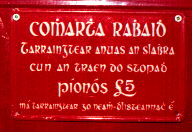 Gaelic -
penalty for pulling cord
Gaelic -
penalty for pulling cord
CIE Craven plate (See supplementary CIE rolling stock
railwayana page)
Wagon plates:
Lamps:
CIE loco and tail.
CIE tail.
See supplementary CIE rolling stock
railwayana page for lamps
Footbridge:
Bridge Restriction:
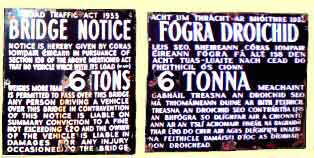 CIE
bridge notice: Source D.Cronin
CIE
bridge notice: Source D.Cronin
Bridge Numbers:
Trespass:
CIE enamels.
See supplementary CIE lineside
railwayana page for two
Gate:
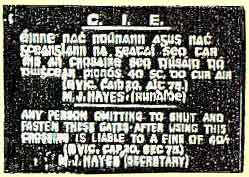 CIE enamel
gate EG1. Source: T.Petchey
CIE enamel
gate EG1. Source: T.Petchey
CIE gate warning. See supplementary CIE lineside railwayana
page
Station:
 GSR/CIE
station Source: D.Cronin
GSR/CIE
station Source: D.Cronin
CIE signal cabin Rathluirc: wood
GSR/CIE Gentlemen.
CIE painted wood 'Ladies Waiting Room'
See supplementary CIE lineside
railwayana page for these
Mileposts:
Miscellaneous:
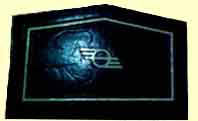 Alloy
signalling cover. Source: D.Cronin
Alloy
signalling cover. Source: D.Cronin
CIE Shunt notice.
CIE enamel bus, badges & buttons.
For these see supplementary CIE
lineside railwayana page
 Return to Index page, or go to CIE
subpage, CIE rolling stock
railwayana.
Return to Index page, or go to CIE
subpage, CIE rolling stock
railwayana. 
 Return to auction
price data on original pages
Return to auction
price data on original pages 
 For genealogy, go to my Lennan
genealogy pages
For genealogy, go to my Lennan
genealogy pages 
Page posted 27/7/1997. Revised 17/1/12